
Concept explainers
Give the structure corresponding to each name.
a.
b.
c.
d.
e.
f.
g.
h.
(a)
Interpretation: The structure corresponding to
Concept introduction: The systematic naming of organic compound is given by IUPAC. The naming of organic compound is done such that the structure of organic compound is correctly interpreted from the name.
Rules for writing structural formula from IUPAC are:
• First identify the word root for the given compound.
• The suffix used in the compound like –ene.
• Identify the position, location, and number of the substituent bonded to the carbon chain.
Answer to Problem 21.44P
The structure corresponding to
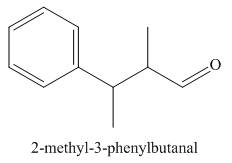
Figure 1
Explanation of Solution
The given name is
The structure corresponding to
(b)
Interpretation: The structure corresponding to
Concept introduction: The systematic naming of organic compound is given by IUPAC. The naming of organic compound is done such that the structure of organic compound is correctly interpreted from the name.
Rules for writing structural formula from IUPAC are:
• First identify the word root for the given compound.
• The suffix used in the compound like –ene.
• Identify the position, location, and number of the substituent bonded to the carbon chain.
Answer to Problem 21.44P
The structure corresponding to
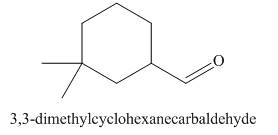
Figure 2
Explanation of Solution
The given name is
The structure corresponding to
(c)
Interpretation: The structure corresponding to
Concept introduction: The systematic naming of organic compound is given by IUPAC. The naming of organic compound is done such that the structure of organic compound is correctly interpreted from the name.
Rules for writing structural formula from IUPAC are:
• First identify the word root for the given compound.
• The suffix used in the compound like –ene.
• Identify the position, location, and number of the substituent bonded to the carbon chain.
Answer to Problem 21.44P
The structure corresponding to
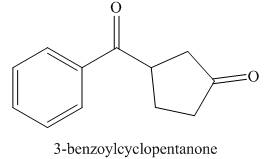
Figure 3
Explanation of Solution
The given name is
The structure corresponding to
(d)
Interpretation: The structure corresponding to
Concept introduction: The systematic naming of organic compound is given by IUPAC. The naming of organic compound is done such that the structure of organic compound is correctly interpreted from the name.
Rules for writing structural formula from IUPAC are:
• First identify the word root for the given compound.
• The suffix used in the compound like –ene.
• Identify the position, location, and number of the substituent bonded to the carbon chain.
Answer to Problem 21.44P
The structure corresponding to
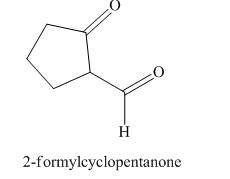
Figure 4
Explanation of Solution
The given name is
The structure corresponding to
(e)
Interpretation: The structure corresponding to
Concept introduction: The systematic naming of organic compound is given by IUPAC. The naming of organic compound is done such that the structure of organic compound is correctly interpreted from the name.
Rules for writing structural formula from IUPAC are:
• First identify the word root for the given compound.
• The suffix used in the compound like –ene.
• Identify the position, location, and number of the substituent bonded to the carbon chain.
Answer to Problem 21.44P
The structure corresponding to

Figure 5
Explanation of Solution
The given name is
The structure corresponding to
(f)
Interpretation: The structure corresponding to
Concept introduction: The systematic naming of organic compound is given by IUPAC. The naming of organic compound is done such that the structure of organic compound is correctly interpreted from the name.
Rules for writing structural formula from IUPAC are:
• First identify the word root for the given compound.
• The suffix used in the compound like –ene.
• Identify the position, location, and number of the substituent bonded to the carbon chain.
Answer to Problem 21.44P
The structure corresponding to
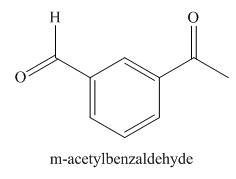
Figure 6
Explanation of Solution
The given name is
The structure corresponding to
(g)
Interpretation: The structure corresponding to
Concept introduction: The systematic naming of organic compound is given by IUPAC. The naming of organic compound is done such that the structure of organic compound is correctly interpreted from the name.
Rules for writing structural formula from IUPAC are:
• First identify the word root for the given compound.
• The suffix used in the compound like –ene.
• Identify the position, location, and number of the substituent bonded to the carbon chain.
Answer to Problem 21.44P
The structure corresponding to
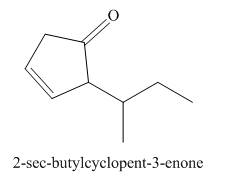
Figure 7
Explanation of Solution
The given name is
In the given compound, one benzaldehyde group is present. The functional group present in the given compound is ketone.
The structure corresponding to
(h)
Interpretation: The structure corresponding to
Concept introduction: The systematic naming of organic compound is given by IUPAC. The naming of organic compound is done such that the structure of organic compound is correctly interpreted from the name.
Rules for writing structural formula from IUPAC are:
• First identify the word root for the given compound.
• The suffix used in the compound like –ene.
• Identify the position, location, and number of the substituent bonded to the carbon chain.
Answer to Problem 21.44P
The structure corresponding to
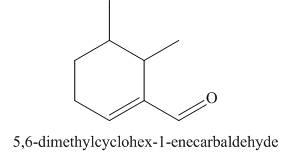
Figure 8
Explanation of Solution
The given name is
The structure corresponding to
Want to see more full solutions like this?
Chapter 21 Solutions
Package: Loose Leaf for Organic Chemistry with Biological Topics with Connect Access Card
- Provide the missing information. *see imagearrow_forwardProvide the missing information. *see imagearrow_forwardDraw the mechanism (including all curved arrows for electron movement) showing how the maleicanhydride is attacked by the anthracene and formation of the final Diels Alder product.arrow_forward
- I have a bottle of butanal that has been improperly used by lab workers. They allowed a traceamount NaOH (aq) to contaminate the bottle. What is now in my bottle of “butanal? What is the molecular name and functional group name? Draw the structure.arrow_forwardProvide the missing information. *see imagearrow_forwardFirst image: Why can't the molecule C be formed in those conditions Second image: Synthesis for lactone C its not an examarrow_forward
 ChemistryChemistryISBN:9781305957404Author:Steven S. Zumdahl, Susan A. Zumdahl, Donald J. DeCostePublisher:Cengage Learning
ChemistryChemistryISBN:9781305957404Author:Steven S. Zumdahl, Susan A. Zumdahl, Donald J. DeCostePublisher:Cengage Learning ChemistryChemistryISBN:9781259911156Author:Raymond Chang Dr., Jason Overby ProfessorPublisher:McGraw-Hill Education
ChemistryChemistryISBN:9781259911156Author:Raymond Chang Dr., Jason Overby ProfessorPublisher:McGraw-Hill Education Principles of Instrumental AnalysisChemistryISBN:9781305577213Author:Douglas A. Skoog, F. James Holler, Stanley R. CrouchPublisher:Cengage Learning
Principles of Instrumental AnalysisChemistryISBN:9781305577213Author:Douglas A. Skoog, F. James Holler, Stanley R. CrouchPublisher:Cengage Learning Organic ChemistryChemistryISBN:9780078021558Author:Janice Gorzynski Smith Dr.Publisher:McGraw-Hill Education
Organic ChemistryChemistryISBN:9780078021558Author:Janice Gorzynski Smith Dr.Publisher:McGraw-Hill Education Chemistry: Principles and ReactionsChemistryISBN:9781305079373Author:William L. Masterton, Cecile N. HurleyPublisher:Cengage Learning
Chemistry: Principles and ReactionsChemistryISBN:9781305079373Author:William L. Masterton, Cecile N. HurleyPublisher:Cengage Learning Elementary Principles of Chemical Processes, Bind...ChemistryISBN:9781118431221Author:Richard M. Felder, Ronald W. Rousseau, Lisa G. BullardPublisher:WILEY
Elementary Principles of Chemical Processes, Bind...ChemistryISBN:9781118431221Author:Richard M. Felder, Ronald W. Rousseau, Lisa G. BullardPublisher:WILEY





